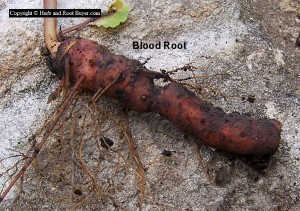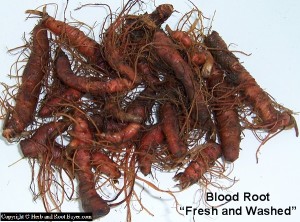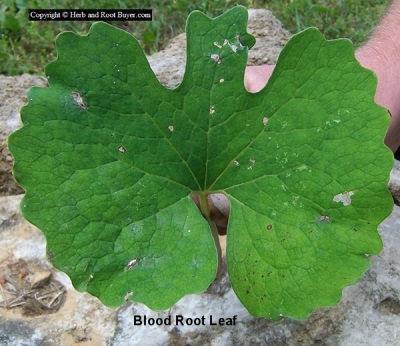Blood Root – Sanguinaria Canadensis
|
Current Demand = GOOD |
Parts Used: Rhizome and Root |
Family: Papaveraceae
Common Names: Indian Paint, red pucoon, red root, coon root, sweet slumber, snakebite…
Description
Blood root has a creeping rhizome and large, single leaves, folded at first, through which the white flowers emerge in the spring. It is a small perennial with roots about finger size. The roots are stout and red-brown, that when cut exude a red juice.
Growing region: Blood root can be found in the Eastern half of the United States and southeastern Canada. It is common thru-out the Midwest and Appalachian region, west to Kansas and north to Minnesota. It is often found in rich moist woods with well drained soil. Bloodroot is a hearty plant and can grow in areas with more sun than shade often along roadsides.
Harvesting/Drying
Parts used: rhizome and root

 For maximum potency Bloodroot should be harvested in the late summer and fall after the seed has matured. Gather the larger more mature plants leaving plenty of younger plants to seed the area for future harvest. Since Bloodroot often grows in very large patches you can often rotate your harvest every three to four years and maintain healthy populations. Deer feed heavily on bloodroot tops so patches which had once been spotted may not be visible the next time you go back.
For maximum potency Bloodroot should be harvested in the late summer and fall after the seed has matured. Gather the larger more mature plants leaving plenty of younger plants to seed the area for future harvest. Since Bloodroot often grows in very large patches you can often rotate your harvest every three to four years and maintain healthy populations. Deer feed heavily on bloodroot tops so patches which had once been spotted may not be visible the next time you go back.
After harvest, the roots should be washed in cold water and foreign material (rocks, dirt and other roots) must be removed. Never soak roots in an attempt to clean them as this will extract vital alkaloids. Separate the stem from the root where the two meet at ground level. Unless the buyer is purchasing fresh dug roots (which they often do) the clean roots need to be dried. Bloodroot can be dried in the sun although if possible dry indoors in a well ventilated barn loft or attic to protect from the elements. If natural heat is not available, heat may need to be added and a fan added for continuous airflow. An old window screen or a wire mesh on a 2×4 frame works well for drying bloodroot. Also, it is a good idea to turn the roots daily as bloodroot holds an abundance of moisture and molds easily, the turning will help prevent molding.
The key to drying herbs, roots or bark is an even combination of heat and airflow. Never dry in an oven or a microwave.
Once the blood root is completely dry (the stem will snap and not bend) in 3-7 days depending on the size of the root and the drying conditions, place in a cardboard box or paper bag for storage in a dry area until you are ready to sell or use. Do not place the root in plastic or it will mold.
Planting
Bloodroot prefers a rich moist soil that is well drained with high organic matter. Moisture is important throughout the growing season. Bloodroot does well in a woods cultivated or artificial shade environment. When an open field is used for production, shade structures should be erected.
Bloodroot seed is not commercially available, and rootstock is very expensive. Propagation is typically done through seed or root division. Bloodroot is more easily propagated by dividing the rhizomes in spring or in fall. Seed can be directly sown into the ground, but the rhizome divisions allow for a faster harvest-able plant.
To plant rhizomes, cut the roots into vertical sections, two inches in length, making sure there is at least one bud attached. There can be up to twelve buds on a rhizome of one bloodroot plant. In a well-prepared three-foot wide bed, plant rhizome pieces deep enough to cover the top of the rhizome with one to two inches of soil (usually around four inches deep). Any fibrous roots connected to the rhizome pieces can remain attached. Stagger plantings six inches apart, making sure the bud is pointed upright when placing the rhizome pieces in the ground. Mulch beds with at least three inches of shredded hardwood mulch or leaf mulch. Add mulch as needed throughout the growing seasons and supply adequate moisture. While bloodroot does not like a soggy soil, irrigation should be provided during dry periods. Plants should be ready to harvest four to five years after planting.
 Root Buyer
Root Buyer